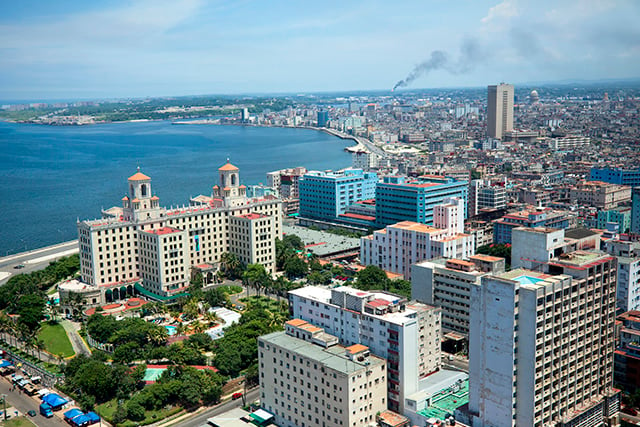- Posted by Jared
- Category:
- 0 Comments
Explore Vedado: Havana’s “forbidden” neighborhood
Havana is Cuba’s capital city and home to more than two million inhabitants. It sits at the mouth of Havana Bay on the Northwest edge of the Caribbean island. Most who have traveled to Havana, or have looked into it, are already well aware of the wonders of the city’s Old Havana district. Sweet Cuban melodies and the fragrant aroma of coffee drift out from living rooms and cafés into cobblestone alleyways. The maze of colorful buildings – some beautifully restored, others sorely in need – opens up onto a number of historic squares featuring the likes of 16th century basilicas and Ernest Hemmingway’s favorite watering holes.
Visitors could easily spend their entire trip to Cuba just exploring Old Havana, but there is so much more to see and do in other parts the city! Part of what makes Cuba’s capital so unique are its distinct neighborhoods, each offering a different flavor of Havana life. For your Cuba tour, do yourself a favor and venture beyond the limits of Old Havana. You won’t regret it.

Vedado is a large, mostly residential neighborhood a few miles west of Old Havana. Thick swaths of forest were converted into a closed military defense zone by Spanish colonizers, hence the name; “Vedado” means “forbidden” in Spanish. Residential development began in the mid-1850s, and the neighborhood was given its characteristic grid system. The streets are numbered and lettered instead of having names, making it one of the easiest places in Cuba for outsiders to navigate.
While Old Havana’s beautifully restored squares offer an unparalleled glimpse into Cuba’s colonial period, Vedado is rich in relics from another fascinating era in Cuba’s history. In the decades following Spain’s defeat in the 1898 Spanish-American war, Vedado was transformed by American investors and those benefitting from Cuba’s sugar trade boom.
One of the best ways to spend a day in Vedado is to simply wander the grid of stunning mansions from this era, each boasting one-of-a-kind Cuban architecture. Nowadays, many of these properties are still single-family homes, but a remarkable number of them were converted into state offices, government-sponsored cultural centers, and embassies after the 1959 Cuban revolution. Imagine going to work every day in a historic mansion with high ceilings and marble staircases!
Vedado landmark hotels like the Hotel Nacional, the Capri, and the Riviera are towering odes to the 1950’s, a period in Cuba’s history notoriously steeped in opulence, gambling, and corruption. Meyer Lansky -- who owned the Riviera before it was nationalized after the 1959 revolution -- and other U.S. mobsters ran casinos, while a decorated string of Hollywood stars frequented spots like the Hotel Nacional.

On your trip to Vedado, you can scour the halls at the Hotel Nacional that are plastered with the names and faces of the celebrities who have wandered those same passages. Afterwards, you can see where Fidel Castro set up defense systems at the hotel during the Bay of Pigs invasion. Lucky for you, the hotel’s grassy backyard patio now serves as one of the city’s most scenic places to sip a mojito, overlooking the seafront esplanade below.
A glimpse of Cuba’s resplendent past isn’t the only reason to visit Vedado. The neighborhood has become an important hub of contemporary Cuban culture. Vedado’s tree-lined avenues certainly offer serenity and a breath of fresh air for the traveler who just spent the day navigating bustling Old Havana. But despite Vedado’s tranquil façade, there is a lot going on beneath the surface.

If you know where to look, the neighborhood is home to some of the country’s best nightlife and a blossoming culinary scene. Many of those high-ceilinged mansions mentioned earlier now house some of the country’s best bars and most innovative restaurants, such as Los Naranjos on 17th and A or Le Chansonnier on 15th and J. Even though these spots might be hiding in plain sight, it certainly doesn’t stop them from filling up. Reservations recommended!
Vedado is also the epicenter of the arts in Havana. A wide of variety Cuban music can be found any night of the week at a plethora of unique venues, including some of the country’s hottest jazz clubs. Vedado has several cinemas, is home to numerous arts and culture festivals, and is always featuring fresh talent in its plays and ballets. What’s more, most of these events are either free or very affordable. A ticket to the latest play to hit the theater will set you back about $5.
Whether you want to cruise past the newly opened U.S. embassy on Havana’s iconic seafront boulevard in a classic car, immerse yourself in Cuba’s rich history, or meet the musicians and artists who are shaping Cuba’s culture today, a trip to Vedado is not to be missed!

Most of InsightCuba’s people-to-people tours of Cuba feature a stay at the Melia Cohiba hotel in the heart of Vedado. The five-star hotel is right on the Malecon, Havana’s seaside boulevard, and offers easy access to the city’s most exciting destinations. All InsightCuba tours come with two expert guides who are available to you 24/7 to help you make your trip to Cuba the experience of a lifetime. Call 800-450-2822 to learn more about the other reasons to travel to Cuba with InsightCuba and to reserve your spot, or visit insightCuba.com to see our 2016 and 2017 Cuba tour dates!
Written by Jaime Hamre
Photos by Robin Thom














